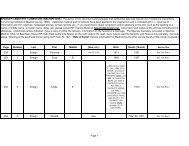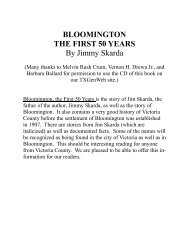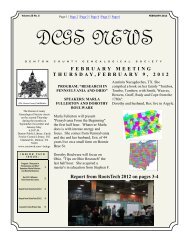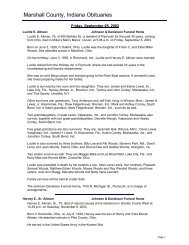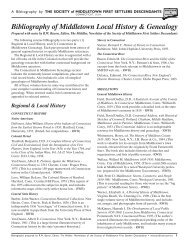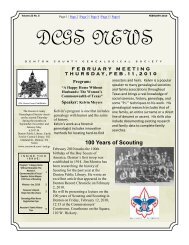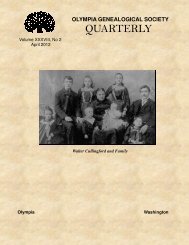Indian population in the United States and Alaska. 1910 - RootsWeb
Indian population in the United States and Alaska. 1910 - RootsWeb
Indian population in the United States and Alaska. 1910 - RootsWeb
You also want an ePaper? Increase the reach of your titles
YUMPU automatically turns print PDFs into web optimized ePapers that Google loves.
STOCKS AND TRIBES, BY SEX, AGE, AND BLOOD. 89<br />
Florida <strong>and</strong> a small b<strong>and</strong>, ma<strong>in</strong>ly of Negro blood, are<br />
located <strong>in</strong> southwestern Texas.<br />
The number enumerated <strong>in</strong> <strong>1910</strong> was 1,729, dis-<br />
tributed as follows: Oklahoma, 1,503; Texas, 200;<br />
Florida, 16; <strong>and</strong> scatter<strong>in</strong>g, 10. The number <strong>in</strong><br />
Florida is much too small. The majority of <strong>the</strong> tribe<br />
are located <strong>in</strong> <strong>in</strong>accessible portions of <strong>the</strong> ETerglades<br />
<strong>and</strong> are very hostile stiE toward <strong>the</strong> whites, allow<strong>in</strong>g<br />
no persons <strong>in</strong> <strong>the</strong>ir territory. The number of Sem<strong>in</strong>oles<br />
thus unenumerated is estimated by a competent<br />
observer, who has been one of <strong>the</strong> few whites to be<br />
allowed to pass through <strong>the</strong> region, at about 200 to<br />
250. This would br<strong>in</strong>g <strong>the</strong> tribal number <strong>in</strong> <strong>the</strong> <strong>United</strong><br />
<strong>States</strong> to nearly 2,000.<br />
This is <strong>the</strong> only one of <strong>the</strong> Five Civilized Tribes<br />
which, accord<strong>in</strong>g to <strong>the</strong> figures <strong>in</strong> <strong>the</strong> reports of <strong>the</strong><br />
Commissioner of <strong>Indian</strong> Affairs, shows a decrease <strong>in</strong><br />
<strong>population</strong>. These figures, like those of <strong>the</strong> o<strong>the</strong>r Five<br />
Civilized Tribes, are based upon <strong>the</strong> enrollment under<br />
<strong>the</strong> Dawes Commission, <strong>and</strong> are much larger than<br />
those reported by <strong>the</strong> census, <strong>the</strong> figures for <strong>the</strong> tribe<br />
<strong>in</strong> Oklahoma <strong>in</strong> <strong>1910</strong> beiag 2,137 from <strong>the</strong> <strong>Indian</strong><br />
reports <strong>and</strong> 1,503 from <strong>the</strong> census.<br />
PIMAN STOCK.<br />
Stock as a whole.— ^The area occupied by this stock<br />
<strong>in</strong> <strong>the</strong> <strong>United</strong> <strong>States</strong> lies wholly <strong>in</strong> southwestern<br />
Arizona. The number enumerated <strong>in</strong> <strong>1910</strong> was .8,607.<br />
The tribes of this stock, for which members were<br />
reported, are as follows:<br />
Mayo. Papago. Yaqui.<br />
Opata. Pima.<br />
Mayo.—A tribe whose habitat is on <strong>the</strong> Mayo Eiver,<br />
m S<strong>in</strong>aloa, Mexico. A small niunber have <strong>in</strong> recent<br />
years emigrated to Arizona where <strong>the</strong>y are now liv<strong>in</strong>g,<br />
ma<strong>in</strong>ly with <strong>the</strong> Pima <strong>and</strong> Papago. The Mayo <strong>in</strong> <strong>the</strong><br />
<strong>United</strong> <strong>States</strong>, as enumerated <strong>in</strong> <strong>1910</strong>, numbered 40,<br />
aU <strong>in</strong> Arizona.<br />
Opata.—A tribe whose habitat comprises <strong>the</strong> region<br />
of <strong>the</strong> upper Yaqui <strong>and</strong> Sonora Rivers, <strong>in</strong> Sonora <strong>and</strong><br />
western Chihuahua, Mexico. A small number have<br />
emisrated to <strong>the</strong> <strong>United</strong> <strong>States</strong>, where <strong>the</strong> number<br />
enumerated <strong>in</strong> <strong>1910</strong> was 5, all <strong>in</strong> Arizona.<br />
Papago.—^A tribe which has long been closely asso-<br />
ciated with <strong>the</strong> Pima. Their habitat, s<strong>in</strong>ce <strong>the</strong> sixteenth<br />
century, has been <strong>the</strong> region south of Tucson,<br />
Ariz., extend<strong>in</strong>g southward <strong>in</strong>to Mexico. For many<br />
years <strong>the</strong>y have been <strong>in</strong> part ga<strong>the</strong>red on <strong>the</strong> Gila<br />
Bend <strong>and</strong> Papago Reservations.<br />
The number enumerated <strong>in</strong> <strong>1910</strong> was 3,798, of which<br />
3,785 were <strong>in</strong> Arizona. Figures for comparison are<br />
uncerta<strong>in</strong> back of 1900. Between 1870 <strong>and</strong> 1890 <strong>the</strong><br />
Papago were estimated variously at from 5,000 to<br />
7,000. In 1900 <strong>the</strong>re were 1,789 actually enumerated<br />
on <strong>the</strong> reservation, <strong>and</strong> an estimated 2,100 o<strong>the</strong>rs who<br />
were nomadic. In 1909 <strong>the</strong>re were 1 ,755 on <strong>the</strong> reserve<br />
<strong>and</strong> 2,225 returned as nomadic. In <strong>the</strong> last 10 years,<br />
<strong>the</strong>refore, <strong>the</strong> Papago have apparently rema<strong>in</strong>ed nearly<br />
stationary <strong>in</strong> nimiber, but have probably decreased<br />
somewhat s<strong>in</strong>ce 1870.<br />
Pima.—One of <strong>the</strong> largest tribes of this stock <strong>in</strong> <strong>the</strong><br />
<strong>United</strong> <strong>States</strong>. Their habitat, s<strong>in</strong>ce <strong>the</strong>y first became<br />
Imown to Europeans <strong>in</strong> <strong>the</strong> sixteenth century, has been<br />
<strong>in</strong> <strong>the</strong> valleys of <strong>the</strong> Salt <strong>and</strong> GUa Rivers <strong>in</strong> sou<strong>the</strong>rn<br />
Arizona. For many years <strong>the</strong>y have been located on<br />
<strong>the</strong> Gila <strong>and</strong> Salt River Reservations.<br />
The number enumerated <strong>in</strong> <strong>1910</strong> was 4,236, of which<br />
4,167 were <strong>in</strong> Arizona. The follow<strong>in</strong>g table, compiled<br />
from <strong>the</strong> reports of <strong>the</strong> Commissioner of <strong>Indian</strong> Affairs,<br />
gives comparative figures for this tribe <strong>in</strong> Arizona<br />
back to 1890, all figures prior to that year be<strong>in</strong>g merely<br />
estimates<br />
:<br />
TEAR.



